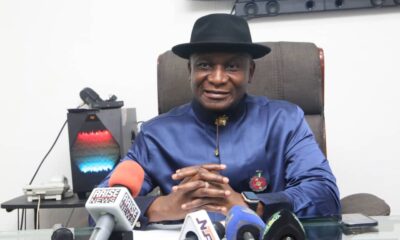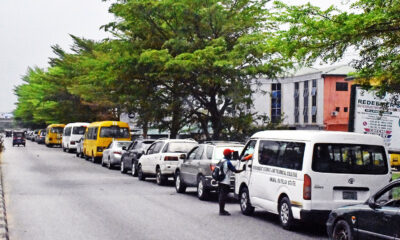Oil & Energy
Hemispheric Implications Of Chavez’s Illness
The recent dramatic pronouncement that Venezuelan President, Hugo Chavez, underwent cancer treatment in Cuba reverberated far beyond Venezuela, depressing his allies and elating his enemies.
While the leader of his self-proclaimed “Bolivarian revolution” is second only to his good buddy Fidel Castro in Washington’s black book, the fact remains that Chavez has discreetly deployed Venezuela’s vast oil and cash reserves to assist the struggling economies of a number of his Central American neighbors, which has earned him deep gratitude.
Ever the showman on alert for any opportunity to tweak Uncle Sam’s snout, in March 2006 in the aftermath of Hurricane Katrina, which damaged the U.S. Gulf oil infrastructure sending domestic prices soaring, he offered shivering New England residents discounted heating oil, infuriating the Bush administration.
Venezuela has the largest conventional oil reserves and the second-largest natural gas reserves in the Western Hemisphere.
But the reality is that Venezuela remains the United States’ fourth largest oil importer, accounting for roughly 1.5 million barrels a day. Should Chavez ever in a fit of pique turn off the taps, the only option that the US would have to replace lost imports would be to turn to Saudi Arabia, the sole OPEC member, and ask them to ramp up production, as Saudi Arabia is the only OPEC member with the reserve capacity to do so.
This in turn would create political problems for Riyadh with other OPEC members, most notably Iran, as under the OPEC system each member state has a pumping quota, and Tehran has already accused Riyadh of breaching its quotas by stealth.
Chavez certainly has reason to be mightily annoyed with US policy, which has been turning up the pressure on Chavez for years while carefully calculating how to avoid a total rupture.
In 2005 Washington classified Venezuela as a country that does not “cooperate in the fight against drug trafficking,” with government officials stating that the lack of assistance should incur financial penalties. The following year the U.S. upped the ante, labeling Venezuela as a country that “does not cooperate sufficiently with the fight against terrorism” and imposed sanctions prohibiting US arms sales to Venezuela or those from any company in the world using US technology.
Upping the ante, in 2007 Chavez announced the nationalization of the country’s oil industry. The foreign oil companies were forced to sign agreements giving majority control of hydrocarbons projects to Petroleos de Venezuela, S.A. (PDVSA), Venezuela’s state-owned petroleum company. Projects owned by companies like ConocoPhillips and ExxonMobil, who failed to sign these agreements, were taken over by PDVSA.
US-Venezuelan relations proceeded to deteriorate rapidly.
Most recently, on 24 June, during the “Sanctionable Activities in Venezuela” hearing in the House of Representatives Foreign Relations Committee, a number of Democratic and Republican House members requested that the Obama administration take more aggressive action against the government of Hugo Chavez. Sub-Committee on Foreign Affairs for the Western Hemisphere head, Connie Mack, a Florida Republican, called the Venezuelan government “terrorist,” adding, “it’s time to act to contain the dangerous influence of Hugo Chavez and his relations with Iran.”
Pandering to the committee members, In testimony before the Committee, the State Department’s Assistant Under-Secretary of State for Latin America, Kevin Whitaker, stated that the administration is “seriously considering” labeling Venezuela a “terrorist state. No option is off the table and the Department will continue to study any further action as may be necessary in the future.”
Washington’s sanctions policy has isolated Cuba and crippled its economy for over fifty years, a relic of a long-gone Cold War.
It appears that Hugo Chaevz’s mortal sin in the eyes of Washington is that he did not come from Venezuela’s traditional white criollo population, less than 25 per cent of the country’s population, which had dominated Venezuela’s politics since the nation achieved independence in 1811. Chavez came instead from the country’s mestizo ethnicity, of mixed European, African, and Amerindian ancestry, which comprises about 65 percent of the country’s population and a working-class background.
Just as Obama smashed the color bar in US politics by being elected to the country’s highest office in 2008, Chavez, elected President in 1998, gave the majority mestizo non-white population not only of Venezuela, but of other nations across Latin and Central America, high hopes that one of their “own” could be elected, who would be more sensitive to their needs than their traditional white criollo elites (of whom his friend Fidel Castro is one), a political seismic shift of historic proportions.
As Washington remained fixated after 11 September 2001 on invading Iraq and Afghanistan, this political shift began to wash across Latin America, most notably with the 2006 election of Bolivia’s Evo Morales.
More important than the ethnicity of the chief executive, however, is that since the early 2000s left-wing political parties have risen to power in most Latin American countries. Besides Chavez and Morales these include Lula da Silva and Dilma Rousseff in Brazil, Fernando Lugo in Paraguay, Nestor Kirchner and his wife Cristina Fernandez in Argentina, Tabare Vazquez and Jose Mujica in Uruguay, the Ricardo Lagos and Michelle Bachelet governments in Chile, Daniel Ortega in Nicaragua, Manuel Zelaya (later deposed in a coup) in Honduras, Rafael Correa in Ecuador, and Mauricio Funes of El Salvador.
Chavez has been at the forefront of attempting to wean these governments away from Washington’s influence, most notably with the establishment of the Alianza Bolivariana para los Pueblos de Nuestra America (the Bolivarian Alliance for the Peoples of Our America,” or ALBA), which Chavez first proposed in 2004. The initial member states were Venezuela and Cuba, but ALBA now also includes Bolivia, Dominica, Ecuador, Nicarauga and the St. Vincent and the Grenadine islands. In August 2008, shortly before the coup, which overthrew him, Honduran President Manuel Zelaya signed an agreement to join ALBA. Further threatening Washington, in October 2009 ALBA leaders agreed a cereate a regional currency, the sucre, to used used in alliance transaction in lieu of both local currencies and the dollar.
Is it any wonder then why Washington sees Chavez as a threat?
Accordingly, the 64,000 bolivares question, not only for Venezuela but Central America and the U.S. as well is – how serious is Chavez’s illness, and what are the implications for Caracas if he is incapacitated? If Chavez leaves the scene, will a new government continue his policy of providing discounted energy to his poor neighbors, most notably Cuba, which receives 64,000 barrels a day, or the Dominican Republic, which pays Venezuela for the 50,000 oil barrels per day that it receives through Petrocaribe with chicken, lard, sugar and pasta? Nicaraguan businessmen are so concerned with the “precarious health” of President Chavez that they are insisting that the Ortega administration immediately negotiate a Free Trade Agreement with Venezuela. If Chavez leaves office, will these countries become more amenable to foreign investment, having nowhere else to turn?
Will a new administration let foreign oil companies back into Venezuela? These and many more questions hinge on the health of a single man, who whatever happens has had more impact on the Latin American political landscape than any other regional political leader of the last dozen years. Love Chavez or detest him, it is impossible to ignore both the man and his impact and the smart money will be gauging carefully the depth and longevity of the impact of the man and his vision should he leave the stage.
Daly writes for OilPrice.Com.
John Daly
Oil & Energy
FG Explains Sulphur Content Review In Diesel Production
The Federal Government has offered explanation with regard to recent changes to fuel sulphur content standards for diesel.
The Government said the change was part of a regional harmonisation effort, not a relaxation of regulations for local refineries.
The Chief Executive, Nigerian Midstream and Downstream Petroleum Regulatory Authority (NMDPRA), Farouk Ahmed, told newsmen that the move was only adhering to a 2020 decision by the Economic Community of West African States (ECOWAS) which mandated a gradual shift to cleaner fuels across the region.
Ahmed said the new limits comply with the decision by ECOWAS that mandated stricter fuel specifications, with enforcement starting in January 2021 for non-ECOWAS imports and January 2025 for ECOWAS refineries.
“We are merely implementing the ECOWAS decision adopted in 2020. So, a local refinery with a 650 ppm sulphur in its product is permissible and safe under the ECOWAS rule until January next year where a uniform standard would apply to both the locally refined and imported products outside West Africa”, Ahmed said.
He said importers were notified of the progressive reduction in allowable sulphur content, reaching 200 ppm this month from 300 ppm in February, well before the giant Dangote refinery began supplying diesel.
Recall that an S&P Global report, last week, noted a significant shift in the West African fuel market after Nigeria altered its maximum diesel sulphur content from 200 parts per million (ppm) to around 650 ppm, sparking concerns it might be lowering its standards to accommodate domestically produced diesel which exceeds the 200 ppm cap.
High sulphur content in fuels can damage engines and contribute to air pollution. Nevertheless, the ECOWAS rule currently allows locally produced fuel to have a higher sulphur content until January 2025.
At that point, a uniform standard of below 5 ppm will apply to both domestic refining and imports from outside West Africa.
Importers were previously permitted to bring in diesel with a sulphur content between 1,500 ppm and 3,000 ppm.
It would be noted that the shift to cleaner fuels aligns with global environmental efforts and ensures a level playing field for regional refiners.
Oil & Energy
PHED Implements April 2024 Supplementary Order To MYTO
The Port Harcourt Electricity Distribution (PHED) plc says it has commenced implementation of the April 2024 Supplementary Order to the MYTO in its franchise area while assuring customers of improved service delivery.
The Supplementary order, which took effect on April 3, 2024, emphasizes provisions of the MYTO applicable to customers on the Band A segment taking into consideration other favorable obligations by the service provider to Band A customers.
The Head, Corporate Communications of the company, Olubukola Ilvebare, revealed that under the new tariff regime, customers on Band A Feeders who typically receive a minimum supply of power for 20hours per day, would now be obliged to pay N225/kwh.
“According to the Order, this new tariff is modeled to cushion the effects of recent shifts in key economic indices such as inflation rates, foreign exchange rates, gas prices, as well as enable improved delivery of other responsibilities across the value chain which impact operational efficiencies and ability to reliably supply power to esteemed customers.
“PHED assures Band A customers of full compliance with the objectives of the new tariff order”, he stated.
Ilvebare also said the management team was committed to delivering of optimal and quality services in this cost reflective dispensation.
The PHED further informed its esteemed customers on the other service Bands of B, C D & E, that their tariff remains unchanged, adding that the recently implemented supplementary order was only APPLICABLE to customers on Band A Feeders.
Oil & Energy
Renewable Energy Boom With Waste Problem

As the global renewable energy capacity increases, so does the amount of waste from end-of-life equipment from solar, wind and other renewable energy activities. If we don’t address this problem soon, it could become a whole new threat to the environment and human health.
While a transition away from fossil fuels to alternative green energy sources is helping the world to reduce its greenhouse gas emissions and combat climate change, it is important to consider the implications that new energy activities may have on the environment.
Solar panels and wind turbines have a limited lifespan and need to be disposed of appropriately once they reach this point. While some components can be recycled and reused, much of the old equipment ends up in landfills due to the lack of infrastructure in place to manage the materials suitably.
Renewable energy equipment, such as solar panels, contains components that can be harmful to humans, such as lead and cadmium, as well as other materials, like glass, aluminum, and silicon, which can be harmful to the environment if disposed of improperly.
One way that out-of-use equipment can be managed is through the creation of standards, such as the Waste Electrical and Electronic Equipment (WEEE) directive from the European Union, which provides guidelines for the gathering, handling, recycling, and recovery of solar panels.
The U.S. Resource Conservation and Recovery Act (RCRA) also addresses the correct disposal of solar panels.
However, many countries have yet to introduce clear standards for renewable energy equipment disposal, which has led to dangerous methods of disposal.
Several countries around the globe are rapidly increasing their solar and wind energy capacity, which relies on the production and installation of millions of solar panels and turbines. Tens of millions of solar panels are being installed each year in the U.S. alone, and globally the figure is over a hundred million.
Despite the accelerated pace of the rollout, there are few recycling facilities prepared to manage old equipment.
Some countries are managing equipment disposal better than others. For example, France claims that 90 percent recycling efficiency is achieved in some of its flagship disposal facilities.
However, others do not have mechanisms in place to even consider recycling old equipment. While it is important to put proper waste disposal mechanisms in place for the safety of people and the environment, it can also be a lucrative business.
According to a study by the International Renewable Energy Agency (IRENA) and the U.S. Department of Energy’s National Renewable Energy Laboratory (NREL), the cumulative value of materials that can be recycled from solar photovoltaic (PV) waste is estimated at $4 billion by 2040 and $8.8. billion by 2050.
Supplies of many of the materials used to produce green energy equipment are finite, meaning it is important to recycle materials to reproduce equipment to continue to produce renewable energy. Jinlei Feng, a programme officer at IRENA, explained, “By 2050, there will be more than 210 million tonnes of cumulative solar PV waste globally and more than three-quarters of that waste will be generated after 2040 and 40% in the last five years between 2045-2050”.
Feng added, “Annual solar PV waste generation will touch 10 million tonnes by 2040 and increase to 20 million tonnes by 2050”.
India is currently trying to navigate solar waste problem. Pavagada in the south of India is home to the world’s third-largest solar power plant, which holds 25 million panels across a 50 km2 park, with a capacity of 2,050MW. There are 11 other giant solar parks across the country, with plans to develop a further 39 across 12 states by 2026.
However, with great solar ambitions comes significant waste. India is aiming for a solar output capacity of 280GW by 2030, of which 70.1GW is already installed.
One study predicts that this will produce an accumulation of over 600,000 tonnes of solar waste by the end of the decade, which could increase 32-fold to over 19 million tonnes by 2050.
Although there are protocols in place to manage the disposal of old equipment, which state that solar waste from the plants must be transferred to e-waste contractors, authorized by the Central Pollution Control Board (CPCB), within a specified timeframe – typically 90 or 180 days – few abide by these rules.
Most solar farms are in remote areas and must pay to transport old equipment to authorised contractors. Solar glass has no real value, meaning there is little incentive for waste contractors to collect and manage the equipment.
This has led to the development of a network of informal operators – who dismantle, aggregate, transport and recycle panels.
Instead of ensuring proper disposal methods are followed, many operators sell their waste equipment to informal buyers, meaning the materials cannot be recycled and repurposed, and many of the materials end up harming both people and the environment.
To ensure that renewable energy equipment is disposed of appropriately, and recycled where possible, governments must establish clear standards and regulations for energy waste disposal.
Further, they must ensure the mechanisms are in place and funding is available to guarantee proper disposal takes place. Without the necessary standards, green energy equipment could contribute to environmental and health problems in the coming decades.
Bradstock writes for Oilprice.com.
By: Felicity Bradstock
-

 Niger Delta3 days ago
Niger Delta3 days agoGroup Dismisses Call For NDDC MD’s Sack … Passes Confidence Vote.
-

 Business3 days ago
Business3 days agoFuel Scarcity: IPMAN threatens shutdown over bridging claims
-
Niger Delta3 days ago
Court Exonerates Ekpeye Monarch, 42 Others From Murder Of Ahoada DPO
-

 Niger Delta3 days ago
Niger Delta3 days agoIbom Air Reiterates Commitment To Healthcare Delivery
-
News3 days ago
Fubara Hails Finidi’s Choice As Super Eagles’ Head Coach
-
News3 days ago
Electricity tariff hike: NBA threatens lawsuit against DisCos
-

 Nation12 hours ago
Nation12 hours agoVCDF in Partnership with LAWMA & Iru LCDA Conducts ‘Street Hygiene & Cleanliness’ Campaign in Lagos
-
News3 days ago
NANS Threatens Nationwide Protest Over Fuel Scarcity

